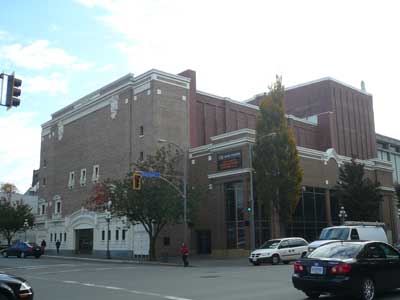Heritage Register
Fairfield
805 Broughton Street
Royal Theatre
Built
1913-14
Heritage-Designated/Commercial
National Historic Site
For: The Victoria Opera House Company
Architects: William D'Oyly Rochfort & Eben Sankey

ARCHITECTURE:
The Royal Theatre has an imposing blocky façade of tapestry brick with white terracotta ornament richly decorated with various motifs, including some with a theatrical theme. Above foundation granite stonework, the whole lower storey is clad in white terracotta and includes a grand arched entrance with four small windows on each side. The central bay projects slightly and is balanced on each side by an almost full height narrow bay with exit doors at street level. Above street level on each side there is a pair of tall leaded art glass windows with pediments above and balconies with balustrades below. Higher still, centred above the entrance arch are three windows framed by dolphins. The decoration is inspired by Renaissance and classical models. The top of the façade is trimmed with a terracotta cornice above a wide frieze terminated by a pair of large florid flat brackets. A row of electric light bulbs outline the three main upper areas of the façade for illumination at night. Shallow lower wings have been added to both sides. Though restored, the theatre entrance sadly lacks a marquee canopy and the doors are now flush.
ORIGINAL OCCUPANTS:
The boom years of the early 20th Century increased the City of Victoria’s “civic pride” greatly and the Royal Theatre is among many important heritage buildings constructed during that era. Now designated a National Historic Site, it was originally named the McBride Theatre, after the premier of the time, Richard McBride.
Impetus for the project came from three prominent Victorians, Simon Leiser, John H. Matson and Richard T. Elliott, who formed a syndicate that evolved into The Victoria Opera House Company. In June 1912, a group of the company’s directors made an extensive tour of the west coast of the United States, to look at existing theatres. They were most impressed by the Orpheum in Seattle and it became the model for Victoria’s new theatre, designed by Rochfort and Sankey and costing $400,000.
Opening night on Dec 29, 1913 was a very grand occasion. The play was Kismet, with the famous actor Otis B. Skinner in the leading role. Premier McBride was there along with Mr and Mrs James Dunsmuir and a host of other eminent citizens. The following day’s Daily Colonist provided columns of rapturous description, with the ladies’ gowns receiving almost as much attention as the new theatre.
The economic downturn before and during WWI made things difficult for the theatre. However, it did contribute to the war effort with weekly variety nights that gave 30% of the proceeds to the Red Cross. In 1915, following the torpedoing of the Lusitania, there were attacks on German-owned businesses in Victoria, among them Simon Leiser’s warehouse. Mr Leiser’s bust, a feature of the Royal Theatre’s lobby, was removed for safe-keeping and never returned.
OTHER OCCUPANTS:
After WWI the Dominion Theatre Co took over the Royal, with Clifford Denham as manager, a position he held for 40 years. The building was acquired by Famous Players in the 1930s and it became a successful movie theatre.
The Royal was purchased by the Capital Regional District in 1973; upgrades included the electrical system, the acoustics, new seating and a new loading area. More recently, a Canadian Heritage grant of $900,000 helped a multi-million dollar restoration, also funded by the Capital Regional District. Allan R. Cassidy directed the façade restoration; this work was recognized in 2006 with awards from Heritage Canada Foundation and Victoria’s Hallmark Society.
ADDITIONAL INFORMATION & IMAGES:
• Statement of Significance (Canadian Register of Historic Places)
• GIS Map of Victoria's Heritage Register Properties
• Fairfield History
• Fairfield Heritage Register
• Royal BC Museum Archives Image 1
• Royal BC Museum Archives Image 2
• Royal BC Museum Archives Image 3
• This Old House, Victoria's Heritage Neighbourhoods,
Volume Four: Fairfield, Gonzales & Jubilee

